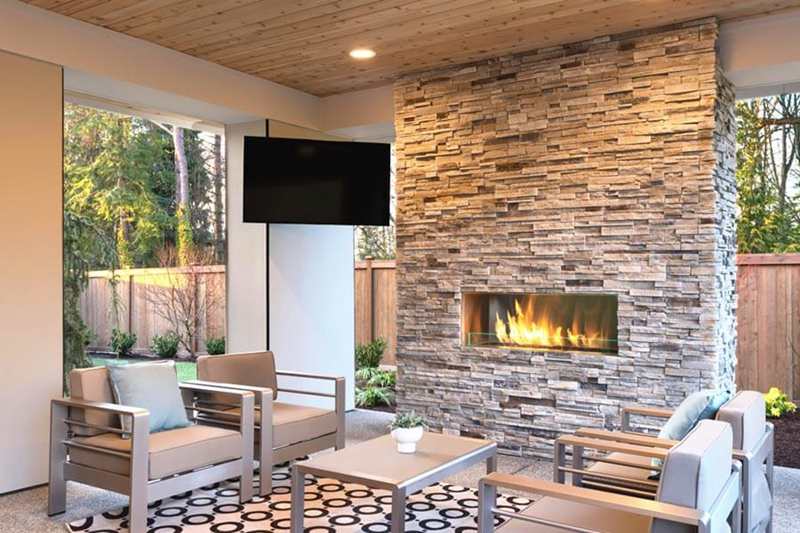Bekymret for at skitt og skitt ødelegger utseendet til deg stablet finerstein? Mange huseiere sliter med å holde steinelementene sine uberørte, spesielt med den naturlige slitasjen de tåler. Sterke kjemikalier kan skade steinen, mens forsømmelse av vedlikehold fører til skjemmende oppbygging og potensiell langsiktig skade.
Derfor er det viktig å mestre skånsomme rengjøringsteknikker og proaktivt vedlikehold. I denne guiden vil vi lede deg gjennom de beste fremgangsmåtene for rengjøring og vedlikehold av den stablede finersteinen din, for å sikre at den beholder sin skjønnhet og holdbarhet i årene som kommer. Med utgangspunkt i vår 15 års erfaring hos Top Source Slate, vil vi dele eksperttips for å holde steinoverflatene dine i utseende “merke-spankin’ ny”.
Viktige forberedelser før rengjøring av stablet steinfiner
Før du begynner å skrubbe, er det viktig å få alt i orden. Riktig forberedelse vil ikke bare gjøre rengjøringsprosessen mer effektiv, men også beskytte din stablet finerstein og dens omgivelser. Denne guiden, brakt til deg av Coco fra Top Source Slate med over 15 års erfaring, sikrer at du takler denne oppgaven som en proff, og opprettholder skjønnheten og integriteten til steinfineren din.
Bruke riktige forberedelsesteknikker før rengjøring stablet steinfiner sikrer både effektiv rengjøring og langsiktig bevaring av steinens utseende og strukturelle integritet.
Vurdere steinfineren: Identifisering av steintype og tilstand
Først, ta en nærmere titt på steinfineren din. Bestem typen stein (skifer, kvartsitt, etc.) og dens tilstand. Er det sterkt skittent, flekkete eller bare støvete? Forståelse av materialet og omfanget av rengjøring som trengs, vil veilede ditt valg av rengjøringsløsninger. Hos Top Source Slate råder vi alltid kundene våre til å kjenne til steinen deres før de begynner med vedlikehold.
Å kjenne tilstanden til din stablet finerstein er livsviktig. Se etter sprekker, løse deler eller eksisterende skade. Å løse disse problemene før rengjøring forhindrer ytterligere skade. For eksempel bør løse steiner limes på nytt, og sprekker skal tettes. Ulike typer stein kan reagere forskjellig på rengjøringsmidler, så bekreft steintypen din og test eventuelt rengjøringsmiddel på et lite, lite iøynefallende område først.
Innsamling av nødvendige rengjøringsmidler: Verktøy og løsninger
Det er avgjørende å ha de riktige verktøyene og rengjøringsløsningene for hånden. Du trenger ting som en myk børste, en hageslange med justerbar sprøytedyse, bøtter og passende rengjøringsløsninger. Bruk alltid produsentgodkjente eller anbefalte rengjøringsmidler for å unngå å skade steinen. Top Source Slate anbefaler skånsomme, pH-nøytrale rengjøringsmidler for å beskytte naturstein.
Unngå sterke kjemikalier som blekemiddel eller syrebaserte rengjøringsmidler. Disse kan misfarge eller erodere steinoverflaten. For gjenstridige flekker, vurder spesielle steinrensere designet for din spesifikke type stein. Når du velger rengjøringsverktøy, sørg for at de ikke er slipende. Slipende børster eller skureputer kan skrape opp overflaten “ride-or-die” stablet finerstein, reduserer utseendet.
Beskytte omkringliggende områder: Forebygge skade
Beskytte områdene rundt din stablet finerstein er et trinn som ofte overses. Dekk til nærliggende planter, vinduer og møbler med plastduk eller slippkluter. Dette forhindrer at rengjøringsløsninger forårsaker skade eller misfarging på disse overflatene. Å sikre disse områdene på forhånd sparer tid og krefter ved opprydding etter rengjøring.
Vær spesielt oppmerksom på å beskytte metalloverflater, siden noen rengjøringsmidler kan forårsake korrosjon. Bruk malertape for å sikre plastfolie og forhindre avrenning. Omdiriger nedløpsrør eller dreneringsområder for å unngå flom eller vannskader under renseprosessen. Riktig beskyttelse sikrer en sikker og effektiv rengjøring.
Sikkerhetsregler: Beskytt deg selv og steinen
Din sikkerhet er viktigst. Bruk vernebriller og hansker for å beskytte deg mot sprut og potensiell hudirritasjon fra rengjøringsmidler. Sørg for tilstrekkelig ventilasjon når du arbeider innendørs eller i lukkede rom. Hvis du bruker en høytrykksvasker, hold trygg avstand og bruk en bred dyseinnstilling for å unngå skade på steinen.
Når det gjelder “rengjøring av steinfiner”, les og følg alltid produsentens instruksjoner for alle rengjøringsprodukter du bruker. Test rengjøringsløsningen på et lite, skjult område av steinen for å sikre at det ikke forårsaker misfarging eller skade. Bland aldri forskjellige rengjøringsløsninger, da dette kan skape farlige gasser. Hold barn og kjæledyr unna rengjøringsområdet for å forhindre utilsiktet eksponering for kjemikalier.
Husk at regelmessig vedlikehold er nøkkelen til å bevare skjønnheten til din stablet finerstein. Med riktig forberedelse og de riktige teknikkene kan du holde steinen på best mulig måte i mange år fremover. For best langtidspleie bør du vurdere å påføre en steinforsegling etter rengjøring, som anbefalt av Top Source Slate. Dette vil bidra til å beskytte mot fremtidige flekker og vannskader. Å følge disse trinnene sikrer en sikker, effektiv og langvarig rengjøringsprosess.

Den ultimate trinnvise veiledningen for rengjøring av stablet steinfiner
Beholder din stablet finerstein å se best mulig ut krever riktig tilnærming. Denne veiledningen gir en detaljert, trinn-for-trinn-metode for rengjøring stablet stein, enten du er huseier eller renholder. Brakt til deg av Coco fra Top Source Slate, med over 15 års erfaring, vil denne veiledningen hjelpe deg å vedlikeholde steinfiner effektivt, og sikre lang levetid og estetisk appell.
“Rengjøring av stablet stein finér involverer skånsomme teknikker og passende rengjøringsløsninger for å bevare steinens naturlige skjønnhet og forhindre skade.
Skånsomme rengjøringsmetoder: Støv- og støvsugingsteknikker
Start med de skånsommeste metodene. Bruk en myk børste eller en støvsuger med børstetilbehør for å fjerne løst støv og rusk fra overflaten av “stablet finerstein”. Dette forhindrer at smuss blir innebygd under dypere rengjøring. Regelmessig støvtørking holder steinen frisk og reduserer behovet for strengere rengjøringsmetoder senere.
Når du støvsuger, pass på å bruke børstefestet for å unngå å ripe steinoverflaten. For vanskelig tilgjengelige områder, bruk en liten børste for å løsne skitten, og støvsug den deretter opp. Dette første trinnet er avgjørende for å vedlikeholde steinfiner og forhindre oppbygging over tid. Regelmessig støvtørking og støvsuging kan forlenge levetiden og skjønnheten til steinen din betydelig.
Dyprengjøringsløsninger: Milde rengjøringsmidler og påføring
For en dypere rengjøring, bruk et mildt, pH-nøytralt vaskemiddel blandet med vann. Påfør løsningen på steinoverflaten med en myk svamp eller klut. Unngå å bruke sterke kjemikalier eller skurende rengjøringsmidler, da disse kan skade steinen. Top Source Slate anbefaler å bruke kun produsentgodkjente rengjøringsløsninger for å opprettholde garantien og steinens integritet.
Når du påfører rengjøringsløsningen, arbeid i små seksjoner for å forhindre at løsningen tørker på overflaten. Skrubb forsiktig steinen, vær oppmerksom på områder med synlig skitt eller flekker. Unngå å bruke for høyt trykk, da dette kan skade steinen. En myk børste kan brukes for strukturerte overflater for å nå inn i sprekker og effektivt fjerne skitt. Husk at tålmodighet og en skånsom tilnærming er nøkkelen til effektiv “vedlikehold av steinkledning”.
Teknikker for fjerning av flekker: Håndtere vanlige flekker
Ulike flekker krever ulike tilnærminger. For oljebaserte flekker, bruk et omslag laget av natron og vann. Påfør omslag på flekken, la den tørke, og skrap den forsiktig av. For rustflekker, bruk en spesialisert rustfjerner designet for stein. Test alltid enhver flekkfjerningsteknikk på et lite iøynefallende område først for å sikre at det ikke skader steinen.
For organiske flekker som alger eller mugg, bruk en løsning av vann og et mildt blekemiddel. Påfør løsningen på det berørte området, la det sitte i noen minutter, og skyll deretter grundig. Bruk alltid hansker og øyebeskyttelse når du arbeider med blekemiddel. Hvis du er usikker på typen flekk eller riktig rengjøringsmetode, kontakt en profesjonell steinrenser. Regelmessig rengjøring hjelper til med å forhindre at flekker setter seg inn, noe som gjør dem lettere å fjerne. Den beste måten å rengjøre stablede steinvegger innebærer ofte å identifisere flekken og bruke en målrettet rengjøringsløsning.
Skylling og tørking: Sikre grundig fjerning av rester
Etter rengjøring og flekkfjerning er det avgjørende å skylle steinen grundig med rent vann. Bruk en hageslange med en skånsom spraydyse for å fjerne alle spor av rengjøringsmiddel. Vær oppmerksom på sprekker og strukturerte områder hvor rester kan samle seg. Resterende rengjøringsløsning kan tiltrekke seg smuss og forårsake misfarging over tid.
Når den er skylt, la steinen lufttørke helt. Du kan bruke en myk, ren klut for å fremskynde tørkeprosessen. Sørg for at steinen er helt tørr før du påfører tetningsmasse eller beskyttende belegg. Regelmessig rengjøring og riktig tørking vil holde deg stablet finerstein ser vakker ut i årene som kommer. Husk å unngå kraftvasker med mindre du har erfaring med dem, da de kan skade steinen hvis de brukes feil. Å følge disse trinnene vil sikre effektiv rengjøring og hjelp “vedlikeholde steinfiner” i årene som kommer.
Sammenligning av rengjøringsløsninger for stablet stein
| Rengjøringsløsning | Effektivitet | Fare for skade | Koste | Anbefalt bruk | Top Source Slate Rating (1–5) |
|---|---|---|---|---|---|
| pH-nøytralt vaskemiddel | Moderat | Lav | Lav | Generell rengjøring | 4 |
| Bakepulver omslag | Moderat | Veldig lav | Veldig lav | Oljebaserte flekker | 4 |
| Spesialisert steinrens | Høy | Lav | Moderat | Vanskelige flekker | 5 |
| Mild blekemiddelløsning | Høy | Moderat | Lav | Organiske flekker | 3 |
| Eddikløsning | Lav | Moderat | Veldig lav | Lett rengjøring | 2 |
Den ultimate guiden for å beskytte og vedlikeholde din stablede steinfiner
Beskytter din stablede finerstein er avgjørende for å opprettholde sin skjønnhet og strukturelle integritet i årene som kommer. Denne veiledningen, brakt til deg av Coco fra Top Source Slate med over 15 års erfaring, fokuserer på langsiktig vedlikeholdspraksis, inkludert forsegling, for å sikre at Stone finér forblir i topp stand. Følger disse tips vil hjelpe deg å vedlikeholde stein finér og holde dem på sitt beste.
Riktig forsegling og vedlikehold er avgjørende for å bevare skjønnheten og forlenge levetiden til stablet steinfiner.”
Viktigheten av forsegling: Fordeler og typer tetningsmidler
Å forsegle din stablede finerstein gir mange fordeler. Den beskytter mot vannskader, flekker og miljøgifter. Tetningsmasser skaper en barriere som hindrer fukt i å trenge inn i steinen, og reduserer risikoen for sprekker og misfarging. Det er to hovedtyper av tetningsmidler: penetrerende og filmdannende. Penetrerende fugemasser trekker inn i steinen og gir beskyttelse innenfra, mens filmdannende fugemasser skaper et beskyttende lag på overflaten. Top Source Slate anbefaler å bruke penetrerende fugemasse for et mer naturlig utseende og langvarig beskyttelse.
Å velge riktig tetningsmasse avhenger av steintypen og den tiltenkte bruken. For utvendige bruksområder, bruk en tetningsmasse som er motstandsdyktig mot UV-stråler og fryse-tine-sykluser. For interiørapplikasjoner, fokuser på flekkmotstand og enkel rengjøring. Les alltid produsentens instruksjoner og velg en tetningsmasse spesielt utviklet for naturstein. Regelmessig tetting er avgjørende for hvordan man vedlikeholder naturstein finer og holder den beskyttet mot vær og vind.
Påføringsteknikker: Hvordan påføre tetningsmasse på riktig måte
Riktig påføring er nøkkelen til å oppnå de fulle fordelene med en fugemasse. Før påføring, sørg for at steinen er ren og tørr. Bruk en børste, rull eller sprøyte for å påføre tetningsmassen jevnt. Unngå å bruke for mye fugemasse, da dette kan skape et blankt eller unaturlig utseende. Påfør et tynt, jevnt strøk og la det tørke i henhold til produsentens instruksjoner.
For best resultat, påfør to strøk med fugemasse, la det første strøket tørke helt før det andre påføres. Vær oppmerksom på skjøter og sprekker, og sørg for at de er helt tette. Tørk av overflødig tetningsmasse med en ren klut. Regelmessig inspeksjon og påføring av fugemasse med noen års mellomrom vil bidra til å vedlikeholde steinfiner og beskytte mot skade. Korrekt påføringsteknikker sikrer din stablede finerstein forblir beskyttet og vakker.
Tips for regelmessig vedlikehold: Forhindrer fremtidig oppbygging
Regelmessig vedlikehold er avgjørende for å forhindre fremtidig oppbygging og beholde din stablet finerstein ser best ut. Støv eller støvsug steinen regelmessig for å fjerne løst smuss og rusk. Rens søl umiddelbart for å unngå flekker. Bruk et mildt, pH-nøytralt rengjøringsmiddel for rutinemessig rengjøring. Unngå sterke kjemikalier eller skurende rengjøringsmidler, da disse kan skade steinen.
Inspiser steinen regelmessig for sprekker, løse biter eller tegn på vannskade. Løs eventuelle problemer umiddelbart for å forhindre ytterligere skade. Hold planter og andre gjenstander borte fra steinen for å forhindre flekker eller misfarging. Ved å følge disse enkle vedlikeholdstipsene kan du forlenge levetiden og skjønnheten til din stablet finerstein. Riktig vedlikehold bidrar også betydelig til effektiv rengjøring av steinfiner. Disse rengjøringstipsene for fasader i steinfiner er uvurderlige.
Feilsøking vanlige problemer: Løsning av potensielle problemer
Til tross for din beste innsats, kan det fortsatt oppstå problemer. Blomstring, en hvit, pulveraktig avleiring, kan oppstå på steinoverflater på grunn av fuktighet. For å fjerne utblomstringer, bruk et spesialisert utblomstringsmiddel. Sprekker eller smuldring kan være forårsaket av vannskade eller fryse-tine-sykluser. Reparer eventuelle sprekker omgående og sørg for riktig drenering for å forhindre fremtidig skade.
Farging kan være et vanlig problem, spesielt i områder med mye trafikk. Bruk passende flekkfjerningsteknikker for den spesifikke typen flekk. Hvis du støter på et problem du ikke kan løse, ta kontakt med en profesjonell steinrestaureringsekspert. Å løse potensielle problemer raskt kan forhindre dem i å eskalere og bevare skjønnheten til din stablet finerstein. Regelmessig vedlikehold og raske reparasjoner vil holde steinen din på sitt beste i årene som kommer. Husk at profesjonelle råd kan være uvurderlige for å takle komplekse problemer.
Sammenligningsskjema for tetningsmasse for stablet steinfiner
| Tetningsmasse | Materialkompatibilitet | Varighet | Vannmotstand | UV-motstand | Prisklasse | Topp kildeskifer anbefaling |
|---|---|---|---|---|---|---|
| Penetrerende silikon | De fleste steintyper | 3-5 år | Høy | Moderat | $$ | Utmerket for interiør |
| Akrylforsegling | Porøs stein | 2-3 år | Moderat | Lav | $ | Budsjettvennlig innendørs |
| Siloksanbasert | Alle steintyper | 5-7 år | Høy | Høy | $$$ | Best for utvendig bruk |
| Fluorpolymer | Følsomme steiner | 7-10 år | Veldig høyt | Veldig høyt | $$$$ | Premium langsiktig |
| Vannbasert | Generell bruk | 2-4 år | Moderat | Moderat | $$ | Enkel påføring |

Konklusjon
Fra mine år kl Toppkildeskifer, Jeg har lært at hemmeligheten til å holde stablet finerstein ser flott ut ikke bare handler om rengjøring – det handler om å beskytte investeringen din. Å kjenne de riktige teknikkene kan spare deg for tid, penger og mye hodepine.
Med den riktige tilnærmingen kan alle holde steinoverflatene sine uberørte. Min erfaring har vist meg at det å kombinere skånsom rengjøring med proaktiv forsegling er en “Rock-Solid” strategi for å opprettholde det vakre, naturlige utseendet i årene som kommer.
Så ta disse tipsene til hjertet. En liten innsats går langt for å bevare skjønnheten og integriteten til steinen din. Og husk, hvis du noen gang føler deg overveldet, er det alltid et smart trekk å nå ut til en profesjonell.
FAQ
Q1: Hva er den beste metoden for å rengjøre stablet finerstein?
A1: Den beste metoden for å rengjøre stablet finerstein er å bruke en pH-nøytral steinrens påført med en myk børste eller klut. Unngå å bruke sure eller blekemiddelbaserte rengjøringsmidler da de kan skade steinens overflate.
Q2: Hvor ofte bør du forsegle steinfineroverflater?
A2: Steinfineroverflater bør typisk forsegles hvert 1-3 år. Frekvensen avhenger av miljøeksponering og slitasjenivå. Påføring av en kvalitetssteinforsegler kan forbedre beskyttelsen mot flekker og fuktighet.
Q3: Kan du bruke en høytrykksvasker på steinfiner?
A3: Det anbefales ikke å bruke høytrykkspyler på steinfiner, da det høye trykket kan skade finerens overflate og løsne steinbitene. Det er best å rengjøre med en lavtrykksslange og unngå harde verktøy.
Q4: Hva slags sealer skal brukes på natursteinfiner?
A4: En penetrerende eller impregnerende sealer er best for Naturstein finér. Det siver inn i porene og gir beskyttelse uten å påvirke steinens naturlige utseende eller forårsake en overflatefilm.
Q5: Hvordan påvirker forsegling utseendet til steinfiner?
A5: Forseglingssteinfiner kan forbedre dens naturlige farge og tekstur, og gi den et vått utseende som forsterker de eksisterende fargetonene. Imidlertid vil bruk av en ikke-forbedrende sealer holde steinens naturlige utseende uendret.
Q6: Finnes det miljøvennlige rengjøringsalternativer for steinfiner?
A6: Ja, miljøvennlige alternativer inkluderer å bruke en blanding av varmt vann og natron eller en spesialisert miljøvennlig steinrens. Disse metodene bidrar til å bevare miljøet samtidig som de holder steinene rene.
Q7: Hva er vanlige vedlikeholdstips for steinkledning?
A7: Regelmessig støvtørking eller vask med mild såpe og vann, forsegling etter behov og inspeksjon for skader for å reparere umiddelbart er viktig vedlikehold tips til steinkledning.
Q8: Forbedrer steinfiner veggens levetid og utseende?
A8: Ja, steinfiner er spenstige og tåler værforhold, og gir langvarig holdbarhet og forsterker den estetiske appellen til vegger med sine naturlige og varierte teksturer.
Eksterne lenker
- Hvordan rengjøre og vedlikeholde steinfiner
- Forsegling og beskyttelse av natursteinfiner
- Innvirkningen av vedlikehold på steinfiner lang levetid
- Effektive rengjøringsteknikker for steinoverflater
- Beste praksis for tetting av steinkledning
- Miljøvennlige metoder for vedlikehold av steinfasade
- Forstå pleie og bevaring av steinfiner
- Rollen til forsegling i bevaring av steindekor


